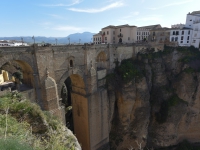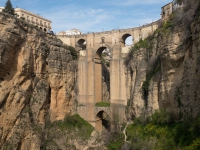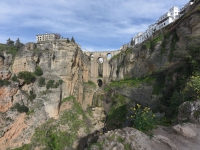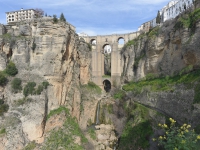Ronda is a little town in the Northwest of Marbella, which is most famous for its “Puento Nuevo” (The New Bridge). In a sightseeing leaflet, which can be picked up from the information office, it reads:
“New Bridge is undoubted the universal emblem of Ronda. It is approximately a 98 meters high bridge which allows us to cross the Guadalevin gorge, better know as Tajo de Ronda and which takes us from medieval times to the modern world. It is furthermore, one of the most important buildings of its period. It has the Interpretation Centre of Puente Nuevo inside which gives us information about its building process and geological formation, the birds making their nests in it, its relation with the landscape and its importance for the development of the city, citizens and distinguished visitors.
In the medieval period, the entrance to the city of Ronda was over the bridge ‘Puente Árabe’, located next to the Arab Baths and which had to be rebuilt several times due to the rises of the river damage. After crossing it, there was a path that surrounded the city of Ronda and lead to the Medina and outskirts.
It was in the modern period, in the 17th century, when the Puente Viejo (The Old Bridge) and the Arco de Felipe V (Arch of Philip V) were built. They connected the city district to the current Padre Jesús district, called at that time flea market and which was founded after the Castilian Conquest.
As a consequence of the urban expansion towards the highest area of the old flea market, called like this due to its inhabitants’ origin, in the 17th century there was already a bridge project in this part of the city, although its execution wasn’t started until 1733. However, this bridge didn’t last very long since it collapsed when it had just been finished leaving a lot of victims.
In 1758, a new building project was approved. Master Gasper Cayón was in charge of this project first and Pedro Fernández since 1763.
In 1777, the construction was stopped and Domingo Loys Monteaguedo was called to take it up. Before and after him, a lot of engineers and masters were in charge of the construction, since many professionals passed by Ronda as it was at the intersection of Málaga, Cádiz and Camp de Gibraltar. It was in 1785 when it was decided to leave the building of the bridge in charge of José Martin de Aldehuela, who had also built the famous aqueduct of San Telmo in Málaga. This architect had the fortune to count on Juan Antonio Díaz Machuca from Ronda, who invented some machines to take the building materials down to the bottom of El Tajo in an easier way.
At last, on the 4th November, 1787, the way for horses and carriages was opened although the building work was finished later because the aqueduct construction had to be integrated into it (1793). As a matter of fact it was Aldehuela who showed the need of using the New Bridge as an aqueduct due to the lack of water in the city district wehere there was no fountains and the water had to be brought with a great effort and a high price.”








